Part 4: Avivo HD vs. PureVideo HD
Discrete vs. Integrated Graphics Benchmarks
For the final test, we’ll compare the CPU usage on the integrated graphics processors against their discrete counterparts, the Radeon 2400 PRO and GeForce 8400 GS. First, let’s compare the Radeons:
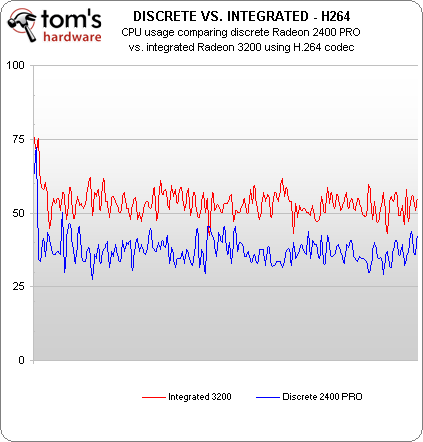
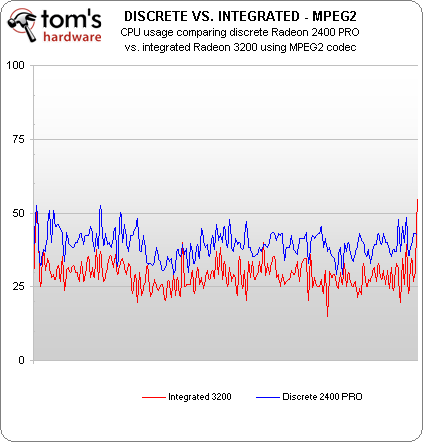
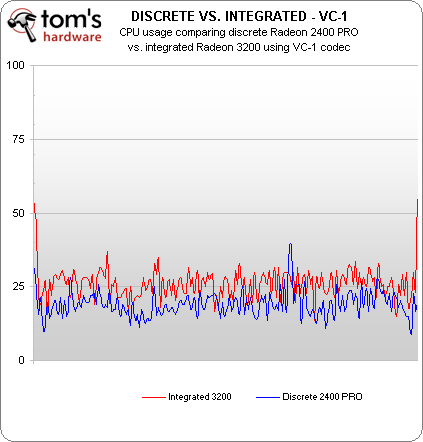
The discrete Radeon 2400 PRO seems to show about a 15% increase in performance over the integrated 3200 when decoding the toughest codec, H.264. This is a notable improvement and makes a strong case for a discrete card.
As for the easier VC-1 and MPEG2 codecs, there is a small performance spread, but CPU usage is below 50% and none of it is really notable. The only point of interest is that the integrated Radeon 3200 shows a slight advantage over the discrete card using the MPEG2 codec.
Now let’s move on to the GeForce solutions:

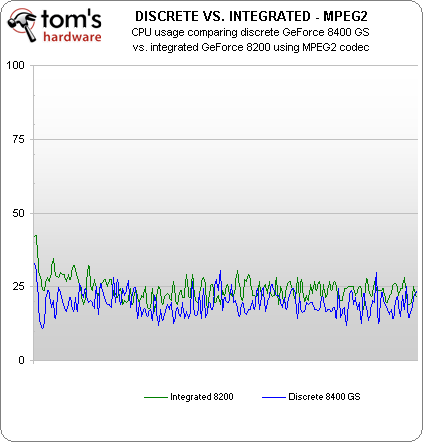
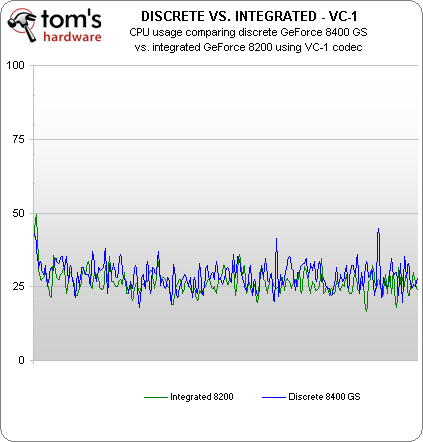
Using the demanding H.264 codec, the discrete GeForce 8400 GS card shows a similar improvement over its integrated counterpart—about 15%—but what’s more important is that the CPU usage spiking on the integrated 8200 is gone on the discrete card. When we consider that the GeForce 8400 GS is not only using less CPU resources, but is providing smooth stutter-free playback and enhanced image quality as shown in our HQV testing, the advantage is hard to ignore.
Get Tom's Hardware's best news and in-depth reviews, straight to your inbox.
Current page: Discrete vs. Integrated Graphics Benchmarks
Prev Page Decryption Benchmarks: Hardware vs. Software Decryption Next Page ConclusionDon Woligroski was a former senior hardware editor for Tom's Hardware. He has covered a wide range of PC hardware topics, including CPUs, GPUs, system building, and emerging technologies.
-
abzillah Don't the 780G chips have hybrid technology? It would have been great to see what kind of performance difference it would make to add a discrete card with a 780G chip. Motherboards with integrated graphics cost about the same as those without integrated graphics, and so I would choose an integrated graphics + a discrete graphic card for hybrid performance.Reply -
liemfukliang Wao, you should update this article part 5 in tuesday when NDA 9300 lift out. 9300 vs 790GX. Does this NVidia VGA also defect?Reply -
TheGreatGrapeApe Nice job Don !Reply
Interesting seeing the theoretical HQV difference being a realistic nil due to playability (does image enhancement of a skipping image matter?)
I'll be linking to this one again.
Next round HD4K vs GTX vs GF9 integrated, complete with dual view decoding. >B~)
-
kingraven Great article, specially liked the decrypted video benchmarks as I was indeed expecting a much higher difference.Reply
Also was expecting that the single core handled it better as I use a old laptop with pentium M 1500mhz & ATI 9600 as a HTPC and it plays nearly all HD media I trow at it smoothly (Including 1080P) trough ffdshow. Notice the files are usually Matroska or AVI and the codecs vary but usually are H264.
I admit since its an old PC without blueray or HD-DVD I have no idea how the "real deal" would perform, probably as bad or worse as the article says :P -
I have a gigabyte GA-MA78GM-S2H m/b (780G)Reply
I just bought a Samsung LE46A656 TV and I have the following problem:
When I connect the TV with standard VGA (D-SUB) cable,
I can use Full HD (1920 X 1080) correctly.
If I use the HDMI or DVI (with DVI-> HDMI adaptor) I can not use 1920 X 1080 correctly.
The screen has black borders on all sides (about 3cm) and the picture is weird, like the monitor was not driven in its native resolution, but the 1920 X 1080 signal was compressed to the resolution that was visible on my TV.
I also tried my old laptop (also ATI, x700) and had the same problem.
I thought that my TV was defective but then I tried an old NVIDIA card I had and everything worked perfect!!!
Full 1920 X 1080 with my HDMI input (with DVI-> HDMI adaptor).
I don't know if this is a ATI driver problem or a general ATI hardware limitation,
but I WILL NEVER BUY ATI AGAIN.
They claim HDMI with full HD support. Well they are lying!
-
That's funny, bit-tech had some rather different numbers for HQV tests for the 780g board.Reply
http://www.bit-tech.net/hardware/2008/03/04/amd_780g_integrated_graphics_chipset/10
What's going on here? I assume bit-tech tweaked player settings to improve results, and you guys left everything at default?
-
puet What about the image enhacements in the HQV test posible with a 780G and a Phenom procesor?, would this mix stand up in front of the discrete solution chosen?.Reply
This one could be an interesting part V in the articles series. -
genored azraelI have a gigabyte GA-MA78GM-S2H m/b (780G)I just bought a Samsung LE46A656 TV and I have the following problem:When I connect the TV with standard VGA (D-SUB) cable, I can use Full HD (1920 X 1080) correctly.If I use the HDMI or DVI (with DVI-> HDMI adaptor) I can not use 1920 X 1080 correctly. The screen has black borders on all sides (about 3cm) and the picture is weird, like the monitor was not driven in its native resolution, but the 1920 X 1080 signal was compressed to the resolution that was visible on my TV.I also tried my old laptop (also ATI, x700) and had the same problem.I thought that my TV was defective but then I tried an old NVIDIA card I had and everything worked perfect!!!Full 1920 X 1080 with my HDMI input (with DVI-> HDMI adaptor).I don't know if this is a ATI driver problem or a general ATI hardware limitation, but I WILL NEVER BUY ATI AGAIN.They claim HDMI with full HD support. Well they are lying!Reply
LEARN TO DOWNLOAD DRIVERS -
Guys...I own this Gigabyte board. HDCP works over DVI because that's what I use at home. Albeit I go from DVI from the motherboard to HDMI on the TV (don't ask why, it's just the cable I had). I don't have ANYDVD so, I know that it works.Reply
As for the guy having issues with HDMI with the ATI 3200 onboard, dude, there were some problems with the initial BIOS. Update them, update your drivers and you won't have a problem. My brother has the same board too and he uses HDMI and it works just fine. Noob...